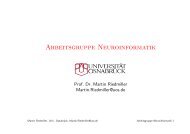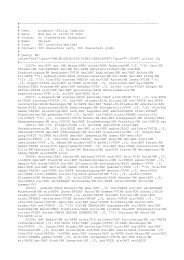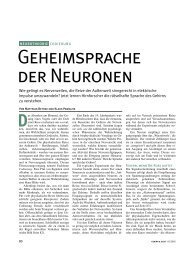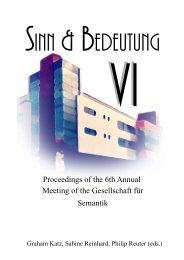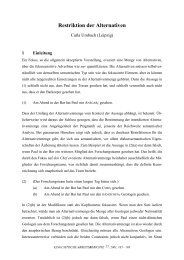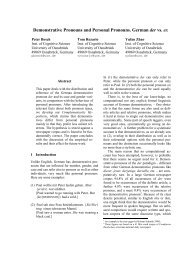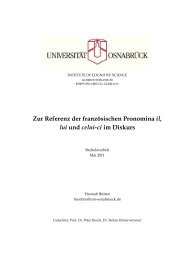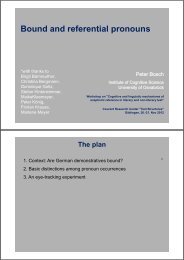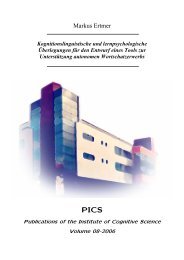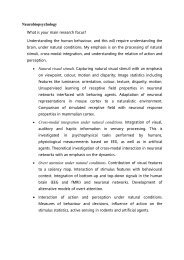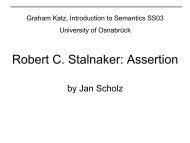Two systems of anaphorically used pronouns in plain text and in ...
Two systems of anaphorically used pronouns in plain text and in ...
Two systems of anaphorically used pronouns in plain text and in ...
You also want an ePaper? Increase the reach of your titles
YUMPU automatically turns print PDFs into web optimized ePapers that Google loves.
3.3 Related notions<br />
• We<strong>in</strong>rich 1993: thematicity (s-pronoun) vs. rhematicity (d-pronoun); d-pronoun is<br />
rarely <strong>used</strong> (!), <strong>in</strong> order to keep the d-<strong>pronouns</strong>’ function as “Aufmerksamkeitssignal”<br />
‘signal <strong>of</strong> attention’<br />
• Delisle 1993: d-<strong>pronouns</strong> is characterised by the notion <strong>of</strong> contrast<br />
• Zifonun / H<strong>of</strong>fmann / Strecker 1997: d-<strong>pronouns</strong> for re-orient<strong>in</strong>g the hearer, s-<strong>pronouns</strong><br />
for ma<strong>in</strong>ta<strong>in</strong><strong>in</strong>g the hearer’s orientation; based on Ehlich’s concept <strong>of</strong> deictic procedure<br />
vs. (ana)phoric procedure: „The anaphoric procedure is a l<strong>in</strong>guistic means to make the<br />
hearer susta<strong>in</strong> a previously established focus towards a specific item. The deictic<br />
procedure is a l<strong>in</strong>guistic means to achieve the focus<strong>in</strong>g <strong>of</strong> the hearer’s attention towards<br />
a specific item.“ (Ehlich 1979)<br />
• Behaghel 1923: “ruhige Weiterführung” ‘calm cont<strong>in</strong>uation’ for s-<strong>pronouns</strong>, “gewisse<br />
Spannung” ‘certa<strong>in</strong> tension’ for d-<strong>pronouns</strong><br />
• similar f<strong>in</strong>d<strong>in</strong>gs (pla<strong>in</strong> discourse) for Dutch by Comrie 1997?<br />
4 Anaphorically <strong>used</strong> <strong>pronouns</strong> <strong>in</strong> reported speech<br />
• d-<strong>pronouns</strong> force an <strong>in</strong>terpretation <strong>of</strong> disjo<strong>in</strong>t reference <strong>of</strong> report<strong>in</strong>g <strong>and</strong> reported<br />
speaker (more ‘basic’ pronom<strong>in</strong>al function than <strong>in</strong> pla<strong>in</strong> <strong>text</strong>).<br />
• k-<strong>pronouns</strong> allow both a coreferential <strong>in</strong>terpretation <strong>of</strong> report<strong>in</strong>g <strong>and</strong> reported speaker<br />
as well as disjo<strong>in</strong>t reference.<br />
• s-<strong>pronouns</strong> <strong>in</strong>dicate coreference <strong>of</strong> report<strong>in</strong>g <strong>and</strong> reported speaker (logophoric?<br />
somewhat unclear data...)<br />
cf. (10) – (12), based on Geyer 2003, ex. 1-50, modified by elicitation:<br />
(10) (und dan håd=ë i gsåchd) naa und des måchd=ë i/j ned<br />
‘und dann hat er i gesagt ne<strong>in</strong> und das macht er i/j nicht’<br />
‘<strong>and</strong> then he i said no, he i/j would’t do that’<br />
(11) und dan håd=ë i gsåchd naa und des måchd deë *i/j ned<br />
‘und dann hat er i gesagt ne<strong>in</strong> und das macht der *i/j nicht’<br />
‘<strong>and</strong> then he i said no, he *i/j would’t do that’<br />
(12) und dan håd=ë i gsåchd des måchd eë i/*j ned<br />
‘und dann hat er i gesagt das macht er i/*j nicht’<br />
‘<strong>and</strong> then he i said no, he i/*j would’t do that’<br />
4



